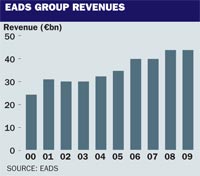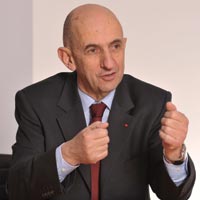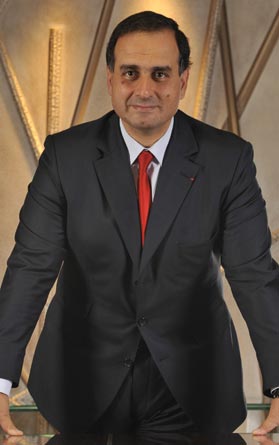Imagine if a decade ago complex negotiations between Germany, France and Spain had broken down and EADS had never been created. It is tempting to think of an aerospace landscape not vastly different to today's.
Airbus would have continued as a four-nation consortium as it had for 30 years. So too Franco-German Eurocopter. Other alliances - such as missile house MBDA - may still have come into being and pan-European programmes including the Airbus Military A400M, the NH90 and Eurofighter would have been fulfilled. Other European and transatlantic alliances may have filled the vacuum.
|
|---|
But this view - which regards EADS largely as a political confection, a bureaucratic corporate layer over a number of successful individual enterprises - is quite wrong, insists Marwan Lahoud, the company's chief strategy and marketing officer.
EADS's individual businesses - without the glue of the parent - would have struggled to withstand the economic shocks of the past decade. European aerospace would be in a severely weakened state. "What company on Earth could have sustained the succession of challenges that EADS has seen?" Lahoud asks.
EADS, he argues, has been successful because of its size and diversity. Created when conglomerates were out of fashion in the business world, the success of its dominant division, Airbus, in the first half of the 2000s "provided the cash and profit to sustain the restructuring of our other activities. Now Airbus is in need," he adds, referring to the investment required to fund A380, A400M and A350 programmes, "other companies are delivering what Airbus needs to continue to deliver."
According to Lahoud, "Airbus would never have survived" the triple blow of the A380 crisis, the A400M delay and the global downturn between 2005 and 2008. By the late 1990s strains were already showing in the old "GIE" [groupement d'intérêt économique] (in which Airbus in Toulouse was a marketing and co-ordination office for the four consortium members), he says. "We would never have integrated Airbus had EADS not been created."
Eurocopter may have continued but with all the management problems of an international joint venture. The space business - which in 2000 was four small, largely self-contained national companies - would never have gone on to become a serious global player, he argues.
 In financial terms, EADS's success has been evident. In euro terms, turnover has increased by 77% over the decade to €42.8 billion ($53.9 billion) in the past financial year. Profits have occasionally dipped severely as a result of various crises, but the net cash position - crucial for the funding of future programmes - has remained strong, increasing almost eightfold between 2000 and 2009 to €9.8 billion.
In financial terms, EADS's success has been evident. In euro terms, turnover has increased by 77% over the decade to €42.8 billion ($53.9 billion) in the past financial year. Profits have occasionally dipped severely as a result of various crises, but the net cash position - crucial for the funding of future programmes - has remained strong, increasing almost eightfold between 2000 and 2009 to €9.8 billion.
"I am extremely proud of what we have done," says chief executive Louis Gallois. "You have to think of where we were at the end of the 1990s. We were very concerned with the way US industry was consolidating and it was clear we had to do something or we would have been pushed into the second league very easily."
When EADS was created, he says, its likelihood of surviving was still uncertain. It was the first time any such organisation had been formed. "Since then, we have created 15,000 jobs in Europe and spent €22 billion on R&D. We could talk about setbacks, but globally we can be extremely proud. We are the only competition to US industry and we are spending more on R&D than any company in this field."
So what do the next 10 years have in store for the world's biggest aerospace company? There are still many "imperfections" in the business model, admits Lahoud. Many of these entail tough choices and some seeming contradictions. Commercial airliners represent 62% of group revenues (and most years a higher proportion of profits), but performance is highly dependent the economic cycle.
Under its so-called Vision 2020 roadmap, EADS is targeting €80 billion revenues, with commercial aircraft representing just half of that. Much of the non-commercial aviation growth will come from "services" that make up just an eighth of turnover in a company still dominated by manufacturing. EADS wants this proportion to grow to a quarter.
Perhaps the biggest challenge for a company rooted in Europe is to increase its industrial footprint, and sales reach - particularly for non-commercial aircraft products - in North America and Asia. Some 70% of EADS's revenues come from outside Europe, but fewer than 10% of its workforce are based there. While this is good for Europe's trade balance, says Lahoud, it has its drawbacks.
US RELATIONSHIP
Unlike its counterparts BAE Systems and Finmeccanica, EADS has not yet made a significant acquisition in the USA. While its Eurocopter and Airbus businesses remain strong there, it has made limited inroads in defence. That is why it regards the current KC-X contest as more important than simply the dollar value of the contract. "The last three years have seen a new stage in our relationship with the DoD [Department of Defense]. We are now regarded as a potential prime for the biggest Pentagon deal of the next 10 years," says Gallois. "That is strong recognition for us."
|
|---|
EADS has recently partnered the United Arab Emirates' Mubadala to open a structures plant in Abu Dhabi and has Airbus and Eurocopter joint ventures in China. Countries such as Brazil, India, Russia, South Korea and Vietnam are also being seriously looked at. The objective is to "build a business model less sensitive to foreign exchange changes without losing the support of our home country governments", says Lahoud.
He adds: "We are not going to send everything abroad because we are a defence company driven by the policy of our domestic customers, and, secondly, our domestic countries are deeply involved in the funding of aircraft programmes through refundable launch aid."
The challenge is to become a global business without EADS losing its European heritage or industrial centre of gravity, says Gallois. "We want to extend our footprint, but not to leave Europe. Our roots are here and I am in favour of a strong industry in Europe. That means keeping facilities here. A company cannot grow without knowing where its roots are."
Source: Flight International






















